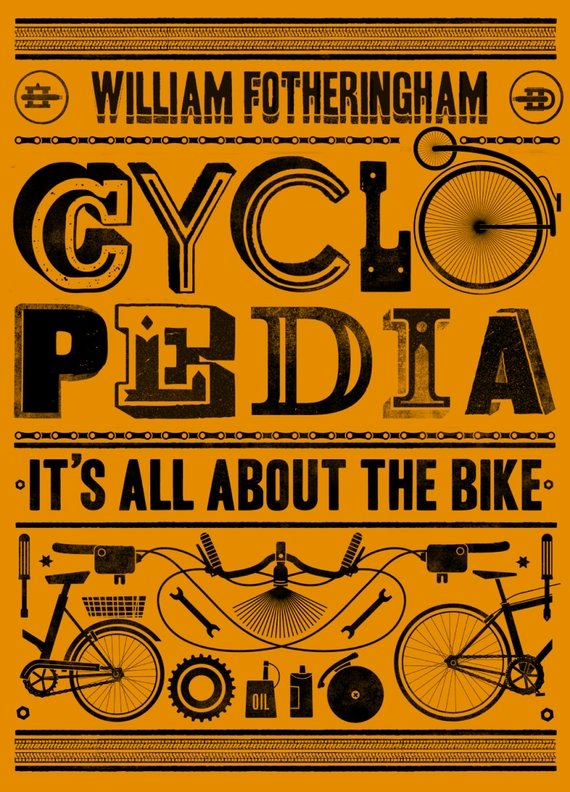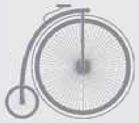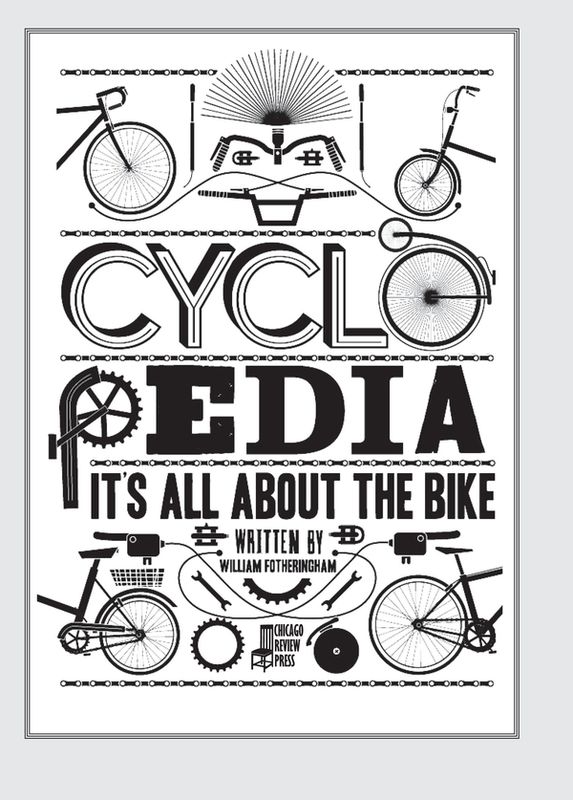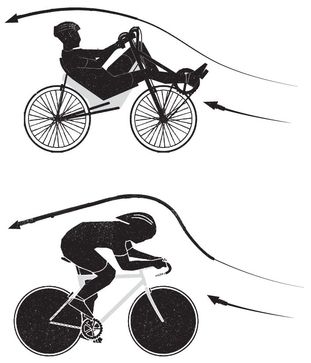Cyclopedia
Authors: William Fotheringham



Also by William Fotheringham
Put Me Back on My Bike: In Search of Tom Simpson
Roule Britannia: A History of Britons in the Tour de France
Fallen Angel: The Passion of Fausto Coppi
A Century of Cycling
Fotheringham's Sporting Trivia
Fotheringham's Sporting Trivia:
The Greatest Sporting Trivia Book Ever II

Design and layout:
www.carrstudio.co.uk
www.carrstudio.co.uk
Â
First published in the United Kingdom by Yellow Jersey Press in 2010
This substantially revised American edition published in 2011 by Chicago Review Press
Copyright © William Fotheringham 2010, 2011
All rights reserved
Illustrations copyright © Telegramme Studio 2010
All rights reserved
Â
We are grateful to BBC
Focus
magazine for permission to use the pedal-power data first published in the October 2009 issue.
Focus
magazine for permission to use the pedal-power data first published in the October 2009 issue.
Â
Chicago Review Press Incorporated
814 North Franklin Street
Chicago IL 60637
814 North Franklin Street
Chicago IL 60637
ISBN 978-1-56976-817-4
Printed in the United States of America
5 4 3 2 1
5 4 3 2 1
Table of Contents
PREFACE

T
he particular joy of cycling is in its infinite variety, its seemingly boundless history. Get on a bike and you can go anywhere, literally and metaphorically. Unlike a football or a tennis racket, a bike has multiple uses. It is simultaneously a piece of high-tech sports gear, a means of transportation to work or the store, a way of discovering the world, an escape to solitude and nature, a social network that beats any of the virtual variety, and a means of discovering your personal limits, whether by crawling up an Alpine pass or shredding your nerves downhill on a mountain bike. Over the last 150 years cycling has helped to change the world and it may yet help to save it from environmental catastrophe. Bikes have carried politicians, soldiers, explorers, suffragettes, socialists, artists, and artisans. Yet as cyclists we tend to exist in our own bubbles. We race, we ride to work, we may fret over whether to buy carbon fiber or titanium, we pedal off to picnics, we find new places. For whatever reason we ride our bikes, and whatever the depth of our personal passion, there will be sides of cycling, its history, its culture, that we don't even know exist. There isn't time to go everywhere and the signposts are not always there in the first place. And that is
where this book may just be able to help, by giving some idea of the multiplicity of areasâsocial, technical, sporting, cultural, historicalâto which two wheels can transport us.
he particular joy of cycling is in its infinite variety, its seemingly boundless history. Get on a bike and you can go anywhere, literally and metaphorically. Unlike a football or a tennis racket, a bike has multiple uses. It is simultaneously a piece of high-tech sports gear, a means of transportation to work or the store, a way of discovering the world, an escape to solitude and nature, a social network that beats any of the virtual variety, and a means of discovering your personal limits, whether by crawling up an Alpine pass or shredding your nerves downhill on a mountain bike. Over the last 150 years cycling has helped to change the world and it may yet help to save it from environmental catastrophe. Bikes have carried politicians, soldiers, explorers, suffragettes, socialists, artists, and artisans. Yet as cyclists we tend to exist in our own bubbles. We race, we ride to work, we may fret over whether to buy carbon fiber or titanium, we pedal off to picnics, we find new places. For whatever reason we ride our bikes, and whatever the depth of our personal passion, there will be sides of cycling, its history, its culture, that we don't even know exist. There isn't time to go everywhere and the signposts are not always there in the first place. And that is
where this book may just be able to help, by giving some idea of the multiplicity of areasâsocial, technical, sporting, cultural, historicalâto which two wheels can transport us.
There is one proviso. This book cannot help but reflect my personal views on a world in which I have been immersed for two-thirds of my life, over 30 years. No one will agree with everything they find here, but that is how it should be. The aim of this book is simply to offer some signposts toward what cycling has to offer, and some guidance through a world of never-ending possibilities. If, after reading it, you want to try something new, go to a race, or buy a book or DVD that you might not have known about, it will have served its purpose.
Â
Enjoy the ride.
Â
William Fotheringham,
July 2010
July 2010

A
ABDUZHAPAROV, Djamolidin
(b. Uzbekistan, 1964)
Â
Squat, tree-trunk thighed sprinter from Uzbekistan who was one of the biggest stars to emerge from the Eastern bloc after the fall of the Berlin Wall. Abdu' first came to prominence in the British MILK RACE, winning three stages in 1986, but it was in the 1991 TOUR DE FRANCE where his unique style grabbed world headlines: he put his head down low over the front wheelâa style later adopted to great effect by MARK CAVENDISHâand zigzagged up the finish straight, terrifying opponents and onlookers.
He took two stages in the 1991 Tour but came to grief in dramatic style as a third win beckoned on the Champs-Elysées: after colliding with an oversized cardboard Coke can standing against the barriers he somersaulted over the bars and rolled down the road. He had to be helped over the line, and was eventually awarded the points winner's green jersey three months later. This led to him being nicknamed the Terminator, because he got back up each time he was knocked down.
He went on to have a memorable feud with Italian sprinter Mario Cipolliniâ“send him back to Russia” was Cipo's lineâand won a total of nine stages and three green points jerseys in the Tour. His career came to an end in 1997 after he tested positive for Bromantan, a drug used by Russian air force pilots; he retired to live on Lake Garda, where he tends pigeons.
Â
(SEE
NICKNAMES
FOR OTHER BIZARRE CYCLING MONICKERS, AND
EASTERN EUROPE
FOR MORE INFO ON THE ORIGINS OF ABDU' AND HIS PEERS)
NICKNAMES
FOR OTHER BIZARRE CYCLING MONICKERS, AND
EASTERN EUROPE
FOR MORE INFO ON THE ORIGINS OF ABDU' AND HIS PEERS)

AERODYNAMICS
If the strength of any cyclist is a given on a particular day, several key variables determine how fast he or she can travel: friction (resistance within the bearings and chain), the rolling resistance of the tires on the road, gravity, and air resistance. Of the four, air resistance is the hardest to overcome and has the greatest effect.
If the strength of any cyclist is a given on a particular day, several key variables determine how fast he or she can travel: friction (resistance within the bearings and chain), the rolling resistance of the tires on the road, gravity, and air resistance. Of the four, air resistance is the hardest to overcome and has the greatest effect.
Air or wind resistance increases as a square of a cyclist's velocity; for every six miles per hour faster a cyclist travels, he must double his energy output. It is estimated that over 15 mph, overcoming wind resistance can account for up to 90 percent of energy output. Estimates vary as to how much a contrary wind can affect speed: some say it slows a cyclist down by half the windspeed (e.g., 2 mph for a 4 mph wind). Roughly a third of air resistance is encountered by the bike, roughly two-thirds by the rider.

The most obvious way to counter air resistance is by sheltering, be it merely by riding close to the hedge when the wind blows or choosing valley roads on a windy day. Riding in the slipstream of another cyclist uses up about 25 percent less energy depending on the size of the rider in front (team pursuit squads look for four cyclists about the same height and width to take advantage of this) and is the key to most of the tactical niceties of road and track racing. A bunch of cyclists riding together offers even greater shelter, as does a pacing motorbike such as a DERNY. Before motor vehicles got too quick, cyclists like FAUSTO COPPI
would go “truck-hunting” to get in speed training.
would go “truck-hunting” to get in speed training.
Changing handlebar position produces immediate results; riding with the hands on the “drops,” not the brake levers, flattens the torso and increases speed by between 0.5 and 1.25 mph. Tucking in any loose clothing helps as well. Shaving the legs produces negligible benefits (see HAIR for other shaggy-cyclist stories), but wearing an aerodynamic teardrop-shaped helmet helps considerably, as does wearing a one-piece skinsuit rather than separate jersey and shorts, and putting covers over the shoes.
So much for the basics. Most recent aerodynamic developments can be traced back to FRANCESCO MOSER and his attempts on the HOUR RECORD in 1982. The Italian used a Lycra hat, shoe-covers, a plunging frame to lower the angle of his torso and reduce the profile of the bike, and solid disc wheels. All became widely accepted ways of reducing air resistance.
Tri-bars, so-called because they were first used by triathletes in the US in the 1980s, were the next major development. They provided the most dramatic recent illustration of the power of aerodynamics when GREG LEMOND used a pair to overturn a 50 second deficit in the final time trial of the 1989 TOUR DE FRANCE. The loser, LAURENT FIGNON, was not riding the extensions, which allow the user to flatten the torso and push the arms forward along the lines of a downhill skier's tuck.
Perhaps the ultimate tri-bar position was achieved by CHRIS BOARDMAN in the mid-1990s. He said of his work in the windtunnel at the Motor Industry Research Assocation in Birmingham, England: “They discovered that if I folded up my body position and tucked in my elbows the drag would be considerably reduced. What I learned was to reduce my frontal area. I have my handlebars about four or five centimeters lower than anybody else.” As a result, if you drove behind Boardman when he was riding
a time trial, all that could be seen of him was his backside: his front end was completely flat, or pointing down slightly to minimize air resistance.
a time trial, all that could be seen of him was his backside: his front end was completely flat, or pointing down slightly to minimize air resistance.
Percentage of drag in the following
:
:
Â
BODY: 80%
Â
WHEELS: 4%
Â
FRAME: 5%
Â
Ways to improve aerodynamics:
Â
TRIATHLON BARS: 10%
Â
DEP. ON BODY SIZE + SHAPE
Â
TEAR-DROP HELMET: 2%
Â
ONE-PIECE SKINSUIT: 2%
Â
SHOE COVERS: 1%
Â
SMOOTHED OUT CARBON FRAME: 2%
Â
DISC WHEELS: 2% DEP. ON WIND DIRECTION
The boundaries were pushed further by GRAEME OBREE in the build-up to his Hour attempt in 1993, when the Scot experimented with a tuck position with his arms up close to his chest. Together with his coach Peter Keen, Boardman ran tests on the Manchester velodrome, riding in various positions and using POWER CRANKS to ensure his power output was relatively constant. Under these controlled conditions, Obree's tuck gave better airflow than either riding on the drops on a conventional bike or using triathlon handlebars. Obree later devised a stretched position known as “Superman”; both this and the tuck were eventually banned.
In the 1990 and 1991 Tours, LeMond rode Drop-In bars, which brought the tri-bar idea to road-racing bars; they had a lowered central section enabling him to get flatter and make his elbows more narrow than on conventional drops (they were also a handy location to put stickers advertising his bar-makers, Scott, for head-on television pictures); in the mid-1990s there was a brief craze for short triathlon-type extensions such as Cinelli's Spinaci bars, which could be fitted to the middle of road racing bars, again enabling the rider to lower his profile. They were banned from 1998 by the UCI; Cinelli are still campaigning for the ban to be lifted.
T
he wind and the drag coefficient of the cyclist and the bike are not the only factors affecting aerodynamics. Air resistance decreases as altitude is gained, because there are fewer molecules in the atmosphere for the cyclist to push through; traveling at 30 mph at 2,000 m above sea level should take about 20 percent less effort. Hence the choice of Mexico City and La Paz for record attempts by riders like CHRIS HOY and EDDY MERCKX.
he wind and the drag coefficient of the cyclist and the bike are not the only factors affecting aerodynamics. Air resistance decreases as altitude is gained, because there are fewer molecules in the atmosphere for the cyclist to push through; traveling at 30 mph at 2,000 m above sea level should take about 20 percent less effort. Hence the choice of Mexico City and La Paz for record attempts by riders like CHRIS HOY and EDDY MERCKX.
Air temperature matters too, with air resistance reducing by about 1 percent for every increase of three degrees Celsius. It has been known for track meeting organizers to keep the doors closed before the home team rides a qualifier in an event such as the team pursuit, so they benefit from a higher temperature. They then open the doors shortly before their main rival goes to lower the temperature by a few degrees. Barometric pressure has an effect as well: the ideal weather conditions for recordbreaking are a high temperature combined with low pressure.
After tri-bars, the most efficient way to improve the aerodynamic profile of a bike is to fit disc wheels. These eliminate the drag produced by a conventional wheel with spokes, which have an uneven drag profile because as they come forward at the top of the wheel rotation they are going at twice the bike's forward speed.
Aerodynamic frame tubes also play a part: they should be teardrop-shaped, but three and a half times as long as they are round to be most efficient. “If a tube is too round, instead of flowing round the tube, the air bounces off it and creates mini vortexes that actually increase drag,” says Boardman. Every part of the bike pulls on the air; hence the British Olympic team's return to the drawing board before the Beijing Games when their techniciansâled by Boardman and the carbon frame specialist Dimitris Katsanisâassessed every last part of their carbon-fiber bikes. The result was smoothed-out handlebars, produced as a single element with the stem; even the wheelnuts were reconfigured to save an estimated 0.005 percent of drag coefficient.
Â
(SEE
BURROWS
,
RECUMBENTS
,
OLYMPIC GAMES
)
BURROWS
,
RECUMBENTS
,
OLYMPIC GAMES
)
Â
AFRICA
Cycling is a vital means of transport here and, in addition, cycle racing goes on in places and ways that few outside the continent know about. To take one example, in Eritrea the influence of Italian colonists from the early 20th century means that cycling is the national sport, with some 800 registered racers in the capital Asmara. The Giro di Eritrea was founded in 1946 and relaunched in 2001, eight years after the end of war with Ethiopia. There are said to be about 100 professionals in the country earning several times the average wage. An Eritrean cyclist, Daniel Teklehaimanot, finished 50th in the time trial in the 2009 world under-23 road race championships.
Cycling is a vital means of transport here and, in addition, cycle racing goes on in places and ways that few outside the continent know about. To take one example, in Eritrea the influence of Italian colonists from the early 20th century means that cycling is the national sport, with some 800 registered racers in the capital Asmara. The Giro di Eritrea was founded in 1946 and relaunched in 2001, eight years after the end of war with Ethiopia. There are said to be about 100 professionals in the country earning several times the average wage. An Eritrean cyclist, Daniel Teklehaimanot, finished 50th in the time trial in the 2009 world under-23 road race championships.
Italian and French colonial influence brought bike racing to the North African coast, and the sport is also strong in other former French colonies such as Burkina Faso and Mali. The Italian Marco Pastonesi interviewed Burkinabe cyclists for his 2007 book
The Craziest Race in the World
; they told him that cycling is the most popular sport in the country. The TOUR DE FRANCE organizers ASO recognize this by running the annual Tour du Faso each autumn. Cycle racing in Burkina Faso goes back to the postwar era, when FAUSTO COPPI came to race there in a series of criteriums in the capital, Ouagadougou, to celebrate the country's independence (it was then known as Upper Volta); after one of the races, Coppi caught the malaria which was to end his life.
The Craziest Race in the World
; they told him that cycling is the most popular sport in the country. The TOUR DE FRANCE organizers ASO recognize this by running the annual Tour du Faso each autumn. Cycle racing in Burkina Faso goes back to the postwar era, when FAUSTO COPPI came to race there in a series of criteriums in the capital, Ouagadougou, to celebrate the country's independence (it was then known as Upper Volta); after one of the races, Coppi caught the malaria which was to end his life.
Colonialism was also responsible for bringing the first African to the Tour de France: Abdel Kader Zaaf was an Algerian who became French national champion in 1942 and 1947, and rode the Tour in 1950 for a North Africa team. Zaaf was involved in a legendary episode when he was riding 16 minutes ahead of the bunch on a baking hot stage in the South of France and was given a bottle of wine by a spectator; the alcohol affected him so badly that he
ended up riding the wrong way down the road.
ended up riding the wrong way down the road.
More recently, in 2007, the South African team Barloworld became the first squad from the continent to race the Tour, when Robbie Hunterâalready the first South African to start the Tour, in 2001âwas the first stage winner from the country at Montpellier (see CAPE TOWN to read about the biggest bike race in Africa and the world). The best African races figure on the UCI's Africa Tour that includes events in Cameroon, Tunisia, Ivory Coast, Morocco, Gabon, Egypt, and Libya. The 2008â9 winner was Dan Craven, a Namibian riding with British squad Rapha-Condor.
In 2009, there were projects under way to turn cyclists in both Rwanda and Kenya into world-class roadmen. The Rwanda project was headed by Jonathan Boyer, the first American to finish the Tour de France. One of his riders, Leonard, was spotted when he kept pace with the team while carrying 150 pounds of potatoes on his bike. The project was set up by Tom Ritchey, one of the founding fathers of the MOUNTAIN BIKE, who set up a race, the Wooden Bike Classic, on which Rwandans could race the basic machines they used to carry coffee from the fields. The project in Kenya, backed by a French hedge fund, aims to transfer to cycling the endurance skills the Kenyans have shown in running.
Other books
Wicked End by Bella Jeanisse
Outcast (The Blue Dragon's Geas) by Matthynssens, Cheryl
The Ebb Tide by James P. Blaylock
Without Scars by Jones, Ayla
Ties That Bind by Debbie White
Stepbrother Soldier's Baby: The Hero (The Complete Series) by Moore, Lila
Bone Walker by Angela Korra'ti
BILLIONAIRE: Protected (A Dark Billionaire Romance) by Royer, Kristina
Among Angels by Jane Yolen